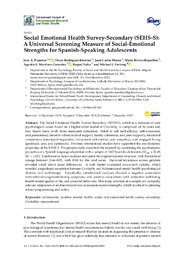Por favor, use este identificador para citar o enlazar este ítem:
https://hdl.handle.net/11000/36027Registro completo de metadatos
| Campo DC | Valor | Lengua/Idioma |
|---|---|---|
| dc.contributor.author | Piqueras, Jose A | - |
| dc.contributor.author | Rodríguez-Jiménez, Tíscar | - |
| dc.contributor.author | Marzo Campos, Juan Carlos | - |
| dc.contributor.author | Rivera-Riquelme, María | - |
| dc.contributor.author | MARTINEZ-GONZALEZ, AGUSTIN ERNESTO | - |
| dc.contributor.author | Falco, Raquel | - |
| dc.contributor.author | Furlong, Michael J. | - |
| dc.contributor.other | Departamentos de la UMH::Psicología de la Salud | es_ES |
| dc.date.accessioned | 2025-03-20T13:26:57Z | - |
| dc.date.available | 2025-03-20T13:26:57Z | - |
| dc.date.created | 2019-12-07 | - |
| dc.identifier.citation | International Journal of Environmental Research and Public Health 2019, 16(24), 4982 | es_ES |
| dc.identifier.issn | 1660-4601 | - |
| dc.identifier.uri | https://hdl.handle.net/11000/36027 | - |
| dc.description.abstract | The Social Emotional Health Survey-Secondary (SEHS-S), which is a measure of core psychological assets based on a higher-order model of Covitality, is comprised of 36 items and four latent traits (with three measured subscales): belief in self (self-efficacy, self-awareness, and persistence), belief in others (school support, family coherence, and peer support), emotional competence (emotional regulation, behavioral self-control, and empathy), and engaged living (gratitude, zest, and optimism). Previous international studies have supported the psychometric properties of the SEHS-S. The present study extended this research by examining the psychometric properties of a Spanish-language adaptation with a sample of 1042 Spanish adolescents (Mage = 14.49, SD = 1.65.). Confirmatory factor analyses replicated the original factorial structure, with hierarchical omega between 0.66–0.93, with 0.94 for the total score. Factorial invariance across genders revealed small latent mean differences. A path model evaluated concurrent validity, which revealed a significant association between Covitality and bidimensional mental health (psychological distress and well-being). Specifically, correlational analyses showed a negative association with internalizing/externalizing symptoms, and positive associations with subjective well-being, health-related quality of life, and prosocial behaviors. This study provides an example of a culturally relevant adaptation of an international tool to measure student strengths, which is critical to planning school programming and policy. | es_ES |
| dc.format | application/pdf | es_ES |
| dc.format.extent | 16 | es_ES |
| dc.language.iso | eng | es_ES |
| dc.publisher | MDPI | es_ES |
| dc.rights | info:eu-repo/semantics/openAccess | es_ES |
| dc.rights | Attribution-NonCommercial-NoDerivatives 4.0 Internacional | * |
| dc.rights.uri | http://creativecommons.org/licenses/by-nc-nd/4.0/ | * |
| dc.subject | adolescents | es_ES |
| dc.subject | positive mental health | es_ES |
| dc.subject | social and emotional health survey-secondary | es_ES |
| dc.subject | Covitality | es_ES |
| dc.subject | measurement | es_ES |
| dc.subject.other | CDU::1 - Filosofía y psicología::159.9 - Psicología | es_ES |
| dc.title | Social Emotional Health Survey-Secondary (SEHS-S): A universal screening measure of Social-Emotional strengths for Spanish-speaking adolescents | es_ES |
| dc.type | info:eu-repo/semantics/article | es_ES |
| dc.relation.publisherversion | https://doi.org/10.3390/ijerph16244982 | es_ES |

Ver/Abrir:
2019_103_Investigacion_Publicaciones_Social Emotional Health.pdf
1,33 MB
Adobe PDF
Compartir:
 La licencia se describe como: Atribución-NonComercial-NoDerivada 4.0 Internacional.
La licencia se describe como: Atribución-NonComercial-NoDerivada 4.0 Internacional.
.png)